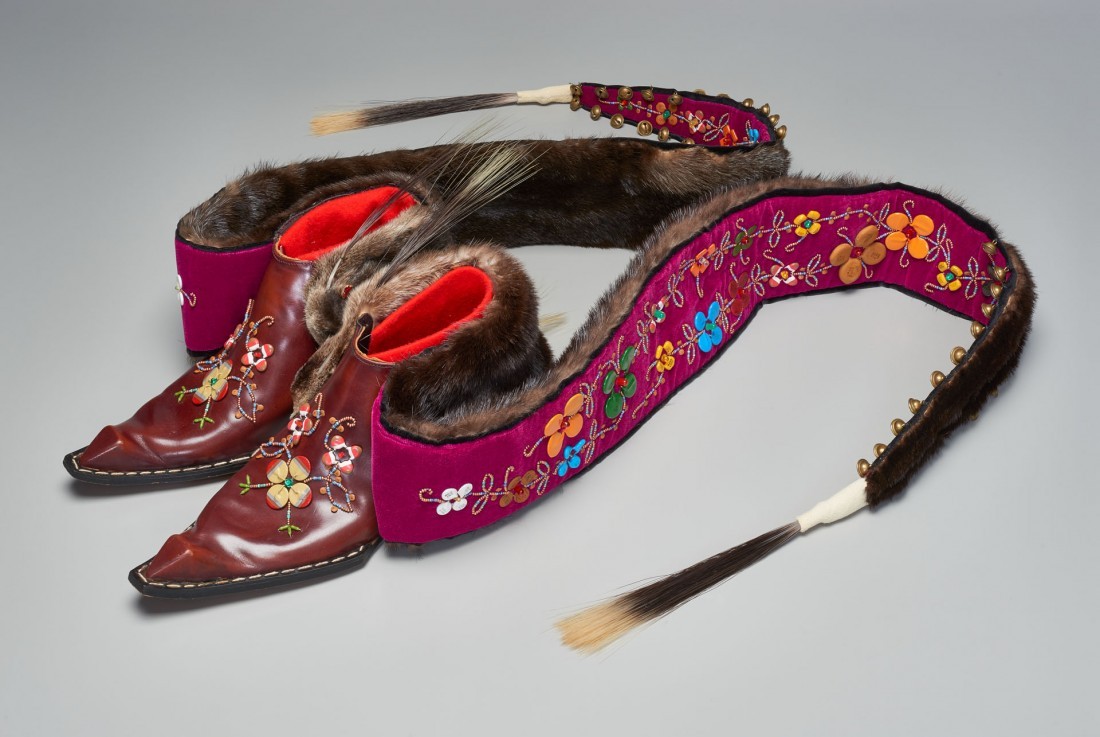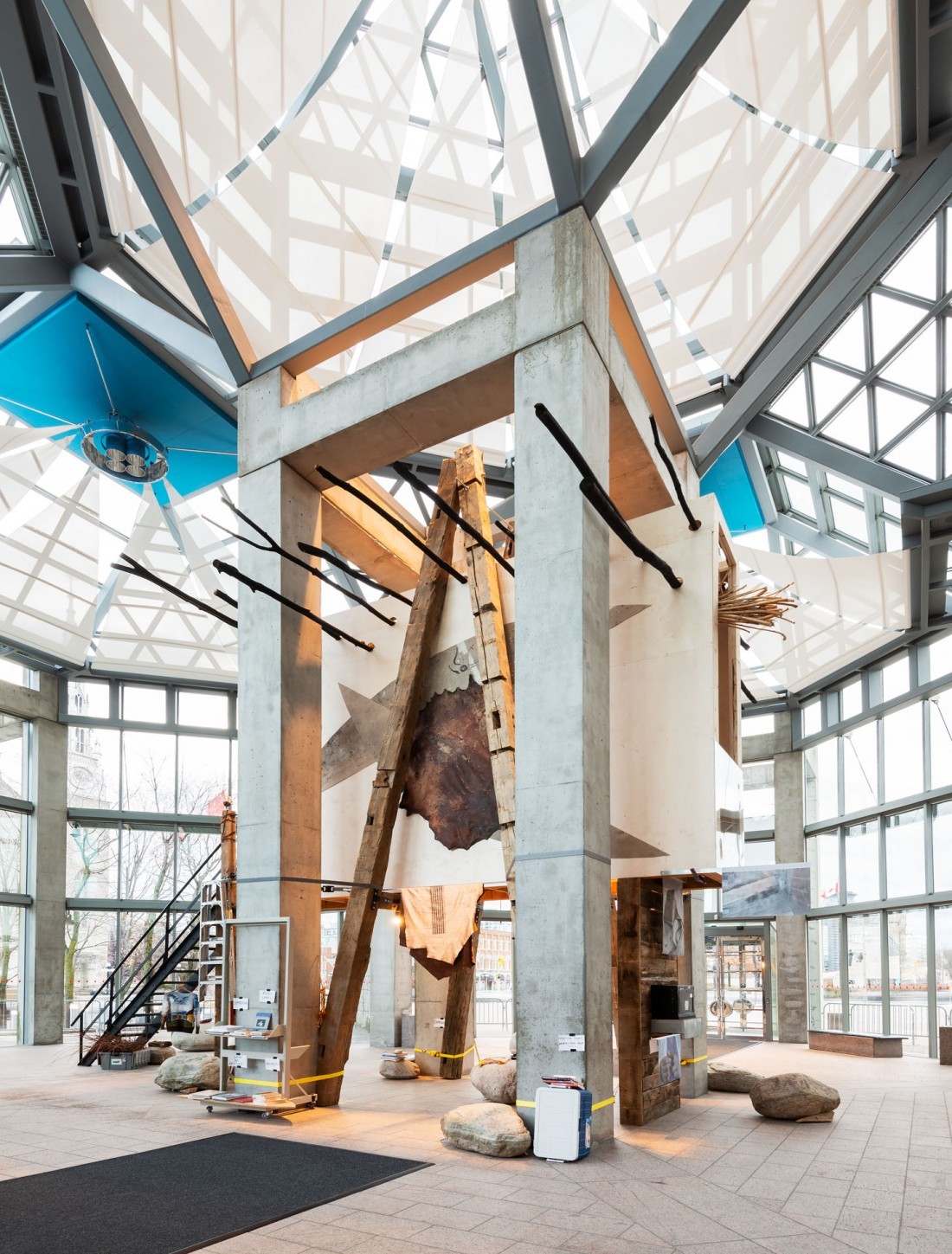“Àbadakone / Continuous Fire”
Métis critic David Garneau has lamented the fact that making space for Indigenous art in Canada often reinforces “settler ownership of display territories,” an argument he made in his article published in C Magazine #145. The National Gallery of Canada (NGC) has “ceded” an unprecedented proportion of its “territory” in “Àbadakone / Continuous Fire / Feu continuel,” but a critical engagement with Indigenous art should do more, and this exhibition does, by emphasizing the knowledge-producing power of its more than 100 works.
“Àbadakone / Continuous Fire” is a follow-up to the National Gallery’s 2013 global Indigenous art exhibition “Sakahàn: International Indigenous Art” (“lighting a fire”). “Àbadakone”’s curators Rachelle Dickenson, Greg A Hill and Christine Lalonde, along with Elders from Kitigan Zibi Anishinaabeg community, signal this in their title, which translates to “the fire continues to burn.” The 70 artists gathered represent Indigenous communities in the Americas, Africa, South and East Asia, the South Pacific, Scandinavia and Siberia, albeit unevenly, with nearly half coming from Canada. The NGC’s location explains this, but the small number of artists from South and Central America, home to some of the best-known pre-colonial Indigenous cultures, is surprising, as is the total absence of artists from China. This kind of accounting is discouraged, however, by a mix of artists in themed rooms that focus our attention on moments of “continuity, relatedness and activation.” A classification of group identities would quantify what is clearly a celebration in “Àbadakone” of the diversity, impact and quality of global Indigenous art.

Barry Ace, Nigik Makisinan—Otter Moccasins, 2014, shoes, otter pelt, velvet fabric, electronic components, synthetic porcupine bristles, deerhide, synthetic felt, copper beads, brass bells. All images courtesy the National Gallery of Canada.
Sámi artist and architect Joar Nango’s Sámi Architectural Library, 2019, in the gallery’s main entrance houses books collected by the artist and fitted with hides tanned on-site by Nango and his collaborators. In addition to volumes on Sámi architecture, key texts in post-colonial theory, feminism and gender studies round out a curriculum for what the artist calls “Indigenuity.” The work testifies to the centrality of Indigenous knowledge systems in the exhibition and in doing so exposes the limits of colonial categories of thought. For Mexican sociologist Rolando Vazquez Melkin, one of the speakers at “Worlding the Global: The Arts in the Age of Decolonization,” a Carleton University global art history conference organized concurrent with the exhibition, decolonial knowledge based in ancestral memory and experiences of the land and language is at odds with the concepts of chronology, space and writing that undergird colonial accounts of Indigenous cultures. In its adherence to such decolonial values (of memory, land and language), Nango’s library provides a fitting lens on works throughout the exhibition, beginning with Joi T Arcand’s ᐆᑌᓃᑳᓅᕁ (ōte- nīkānōhk), 2018, brightly coloured words of welcome in Plains Cree that lead from the entrance to the Great Hall.
Some of the exhibition’s most poetic works mobilize ancestral memory to dismantle the colonial figure of the ‘disappearing Indian.’ To that figure’s implied passivity, artists respond with lessons in wilful Indigenous dissimulation. Anishinaabe artist Barry Ace’s Nigik Makizinan—Otter Moccasins, 2014, a modified pair of trail dusters or shoes with features that erase the wearer’s tracks, includes floral adornments made with electronic components like capacitors and resistors. If, according to colonial chronologies, the ‘disappearing Indian’ belonged to a bygone stage of world history, Ace’s sci-fi footwear recasts that disappearance as a technique for avoiding capture, and one that points ahead to tracking digital footprints in our time. Diné/ Navajo artist Will Wilson’s portrait K’ómoks Imperial Stormtrooper (Andy Everson), Citizen of the K’ómoks First Nation, 2017, also pits Indigenous futurity against colonial timelines with its iconic image of a Star Wars storm trooper’s helmet camouflaged with traditional Kwakwaka’wakw designs.
The most stunning engagement with ancestral memory is offered in Nenets artist Evgeniy Salinder’s collection of 27 antler ivory and fossil figurines titled Sikhirtya and Animal Figures, 2017. Whereas colonial anthropologists consolidated their knowledge of Indigenous peoples within a salvage paradigm, Salinder’s representation of the Sirtya—inhabitants of northern Siberia before the Nenets—attests to their contemporaneity as sources of guidance. As they are said to live underground, the Sirtya might also be regarded as sharers with the Nenets of an experience of the Siberian tundra.
This feature of Indigenous knowledge—its privileging of a land experienced over abstract, measurable and colonized space— lies behind the exhibition’s most explicitly political works. In a tightly curated room, the problem of land for Indigenous communities is described in terms of mapping, borders and territorial disputes. Fernando Poyón’s A Light, A Shadow, 2017, reimagines the map of the world, Pangea-like with fused continents, to distribute his native Mayan culture in a global context. Anishinaabe artist Maria Hupfield’s Electric Prop and Hum Freestyle Variations, 2017–19, offers a more performative take on the reordering of borders. In it, construction vests and a felt helmet with tin jingles hang on a wood structure near headphones for a video recording of the performance. For the performance at the NGC, Hupfield and her collaborator, Ange Loft, moved through the space, donning the vests and helmet and rearranging idle beams to mark boundaries on the ground. On a long black banner hung behind them, we read a fragmented “land acknowledgement”: “Land and and and and + + speaksolidaritybuild …” The message conveys the resolve of Indigenous land claims, their sadly required repetition and the unshakable hope for justice from which they proceed. Kaska Dene artist Josph Tisiga’s The Game is Not a Game, 2016, and An Exercise in Resilience 1, 2, 3, 2016, anchor the room’s meditations on borders in historical realities. On faded copies of architectural plans for a residential school in Whitehorse, Tisiga’s hastily scrawled statement “the game cannot be won” reins in Hupfield’s and Poyón’s measured utopianism. The posters are hung around a bird’s-eye view of a mock golf course in which the greens are indicated with artificial grass and the hazards are cut-out animal furs. A thinly veiled reference here to the golf course expansion that caused the Oka Crisis sets up a contrast between Poyón’s and Hupfield’s emancipatory play and the exorbitant social and spiritual cost of settler leisure.

Joar Nango, installation view, Sámi Architectural Library, 2019, installed at the National Gallery of Canada. Collection of the artist.
“Àbadakone” had the good and bad fortune of running during the Wet’suwet’en protests against the Coastal GasLink pipeline and, later, a global pandemic. The curators could not have anticipated how apt their theme of “activation” would turn out to be. Pitched, in part, as a theme for the many events and performances in the exhibition, it turned out as well to capture “Àbadakone”’s responsiveness to history unfolding beyond the gallery’s walls. Cree artist Ruth Cuthand’s beaded renderings of the smallpox, Spanish flu and pneumonia viruses from the “Reserving Series,” 2011–13, for example, provide an immense opportunity for settler empathy amid the COVID-19 pandemic. But the exhibition’s goal of forging bonds across national and cultural boundaries seems especially worth remembering as we are forced to think about the global in terms of contagion, risk and isolation. Anishinaabe artist Rebecca Belmore’s marble pup tent titled Biinjiya’iing Onji (From Inside), 2017, is one of the most compelling works in this regard. Positioned just outside the entrance to the first gallery, it functions provocatively as both obstacle and invitation. Its references to Greek statuary and blankets used by refugees in temporary camps the world over call a European nationstate model of citizenship into question, and propose in its place a human condition defined now more than ever by vulnerability, care and exposure. ❚
“Àbadakone / Continuous Fire / Feu continuel” was exhibited at the National Gallery of Canada, Ottawa, from July 23 to October 4, 2020.
Tammer El-Sheikh is an assistant professor of art history at York University.

